
ERCIM News 66July 2006Special theme: European Digital Library Contents This issue in pdf Subscription Archive: Next issue: October 2006 Next Special theme: |

by Mark Roantree and Zohra Bellahsène
The Bologna Process was initiated in 1999 by 29 Education Ministers of the EU, with the aim of providing a single European Higher Education Area (EHEA). Its goals were to promote mobility across EU states by standardizing the education programmes in all states, and by 2010, to provide a system of constructing degree programmes across multiple states. In effect, this means that the EHEA System becomes a vast digital library with the appropriate data-management functionality. This presents a major challenge to educational institutes as they prepare to modify their systems for incorporation into the EHEA Digital Library.
There are five broad goals to the Bologna Agreement: a system of easily readable and comparable degrees; a system with two study terms; the establishment of a system of credits; the promotion of mobility and European cooperation in quality assurance; and the promotion of the necessary European dimensions in higher education. To achieve this, the issues that must be overcome are integrating the very large number of databases that contain education programmes, dealing with the heterogeneity of the systems involved, and designing a single query interface to the EHEA Digital Library.
The XPeer Architecture
The XPeer Framework emerged from a collaborative effort between Dublin City University and the University of Montpellier to design a large-scale database architecture together with Query and Metadata Services. This research examined scenarios in which it was necessary to write complex queries for large numbers of heterogeneous pre-existing databases and information systems. This project faced the same issues as Bologna institutes: management of an extremely large system of databases where old information disappears and new information is made available on a regular basis. This is essentially what takes place when old courses or subjects are decommissioned and new ones emerge.
Data integration is a significant challenge: relevant data objects are split across multiple information sources and are often owned by different organizations. The sources represent, maintain and export the information using a variety of formats, interfaces and semantics. XPeer is a peer-to-peer (P2P) architecture with each peer representing a single database through an XML interface. In the Bologna context, a peer may contain a single course module or a group of modules within the educational institute and it is assumed that each institute provides any number of information peers. The XPeer Architecture is novel in that it adopts the 'super-peer' concept, which was first employed in networking terms to denote a peer of greater importance. In XPeer, we use this concept to integrate common peers, and thus define groups such as 'All modules in Europe for Final Year Computer Graphics students', 'Database courses in Europe delivered in English', 'Networking Courses in French Universities', or '1st Year Java Programming in Ireland, Greece and Germany'. In this way, we have introduced a two-tiered system with databases (peers) on one level and super-peers (integrated systems) on the second level. In Figure 1, the clusters Ci, Cj and Ck are formed using course module databases from various institutes.
 |
| XPeer framework for the EHEA Digital Library. |
Managing the Large-Scale Digital Library
The super-peer is the access point for users in the XPeer System, and for other super-peers that wish to communicate within the system (to resolve queries internally). It is the underlying P2P framework that supports the large-scale element to the system, as there is no central control point and therefore no bottleneck or limit to the number of participating systems. The super-peer concept permits the creation of 'clusters' of interesting systems for end-users. However, as the system grows, it is necessary to introduce a form of classification to assist with query optimization. As peers join the system, they are classified within the the existing set of domains. When XPeer is used to model the Bologna Process, these domains become the major disciplines such as medicine, computing, history and engineering. Thus, while the P2P approach allows for an infinitely large digital library, the classification process ensures that the library is ordered, and the integration process (super-peer) provides a global interface to collections of related databases. Thus, peers are accessed through super-peers; super-peers belong to a specified domain; and finally, a global peer (replicated to avoid performance issues) is used to manage the set of domains.
Current and Future Work
Current research efforts are focused on the provision of query and metadata services for the EHEA Digital Library. The Query Service uses the XPath Query Language, boosted by a fast indexing system and result-merging process to facilitate distributed querying on a large scale. The Metadata Service also uses the XPath language, extended to allow network creation, the addition and removal of peers, the promotion of common peers to the role of super-peer, the addition and removal of domains and so on. The project is expected to conclude at the end of 2008 with a set of fully specified services to support the large EHEA digital library.
Links:
XPeer publications: http://www.computing.dcu.ie/~isg
Bologna Agreement: http://www.euractiv.com/en/education/bologna-process/article-117448
Please contact:
Mark Roantree, Dublin City University, Ireland
E-mail: Mark.Roantree![]() Computing.DCU.ie
Computing.DCU.ie
Zohra Bellahsène
University of Montpellier II, France
E-mail: bella![]() lirmm.fr
lirmm.fr